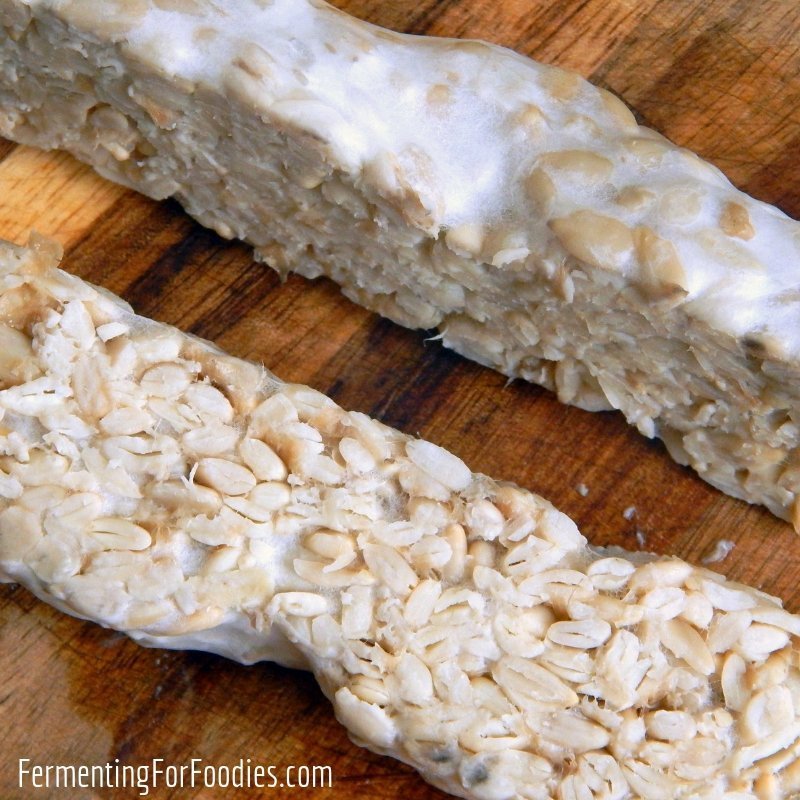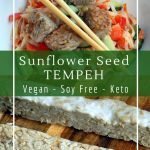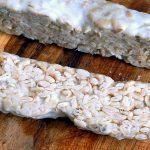Homemade pumpkin or sunflower seed tempeh is nutty and delicious. It is the perfect vegetarian and vegan protein. Since it is firmer and crunchier than traditional soybean tempeh, it is great for barbecues, stir-fries, and sandwiches.

Sunflower seed tempeh happens to be my favorite. I love the flavor and texture. It’s also nice to have an alternative to the beans, lentils, and tofu that make up most of our diet. Sunflower seeds are low carb, grain-free, and keto-friendly! What’s not to love?
Basic tempeh information
Here is some general advice about tempeh. I recommend starting here if it’s your first time making tempeh.
- Culture: Look for tempeh spores at an Indonesian grocery store or find them online. You only have to buy them once because it’s easy to make your own tempeh starter.
- Fermenting Container: Tempeh needs to be spread out in a 2 cm thick layer in a vented container for fermentation. If you plan on making a lot of tempeh invest in a plastic container, otherwise, use a plastic bag. Use a pushpin to poke holes at 1 cm intervals so the container/bag is properly vented.
- Incubation: Tempeh needs to be incubated at around 85-90 F. I use a folding fermentation box for all my heated ferments. Other options include: incubating in the oven with the light on, near a radiator or a hot water heater. You could use a dehydrator set to the right temperature. The only trick is to measure the temperature after 12 hours because tempeh starts to create heat as it ferments, so you may need to adjust.
How to Store Tempeh
Raw tempeh is creamy and delicious. The mold is reminiscent of Brie or Camembert. Raw tempeh needs to be eaten with 3-5 days, because the mold will continue to grow and spore, even in the refrigerator.
Generally, tempeh is steamed before eating. Steamed tempeh will last for a week in the fridge or it can also be frozen for up to three months.
How to steam tempeh
- Steam tempeh either in whole blocks or cut into smaller chunks.
- You can steam in a steaming basket or in a metal colander over a pot of boiling water.
- Steam tempeh for 20 minutes.
- After it’s been steamed, tempeh will last for several weeks in the fridge. Alternatively, freeze tempeh for long-term storage.
Sunflower Seed Tempeh
Sunflower seed tempeh is a delicious and nutritious soy-free tempeh. It is a great keto-friendly, vegetarian and vegan protein substitute. It is firm enough for a stir-fry, barbecue, or eat it fresh.
- Prep Time: 10 minutes
- Cook Time: 1 hour
- Total Time: 1 hour 10 minutes
- Yield: 2 cups 1x
- Category: Main Dish
- Method: Fermented
- Cuisine: Healthy
- Diet: Vegan
Ingredients
- 2 cups of hulled sunflower seeds (or pumpkin seeds)
- 2 Tbsp white vinegar
- 1 tsp tempeh starter
Instructions
- Bring the sunflower seeds to a boil and simmer until the seeds are soft (about 1 hour).
- Drain the sunflower seeds and allow them to cool until they are just above room temperature.
- Mix the sunflower seeds with the vinegar to lower the pH of the ferment. This prevents unwanted bacteria from contaminating the tempeh.
- Sprinkle on the tempeh starter and mix well.
- Spread the sunflower seeds out in the fermentation container. (See the section above for more details).
- Incubate at approximately 88 F (31 C).
- Check the seeds after 12 hours. At this point, the mold will have started to grow and the tempeh will start to generate heat. Depending on what you are using for incubation, you may need to lower the temperature.
- The tempeh will be done sometime between 24 and 48 hours. It’s ready when the mold has thickened the sunflower seeds into a single dense mass. There might be some grey or black mold spores, but you want to stop incubation before there are too many mold spores.
- See the section above for details on steaming and storing tempeh.
Notes
- Black and gray spots may appear on the tempeh. These are mold spores, and they are completely edible. The tempeh should smell nutty and mushroomy, and it might have a hint of ammonia. I have never had a tempeh failure, however, if your tempeh smells bad, is mushy, or slimy then throw it out.
- See the sections above for more information on the type of container you should use for tempeh, and how to maintain the right temperature.
- Feel free to make tempeh out of pumpkin seeds using the same instructions. If you want to try sesame seeds, then only add a small amount to your batch of sunflower seed tempeh.


This is a very helpful blog. I see somewhere you wrote that the fermentation needs air (or something like that). If I ferment in a cooler box, but keep the cooler box sealed for insulation to maintain the temperature, will that give the spores enough oxygen? I guess the cooler box is about 30litres so there will be plenty of air – it just won’t be circulating.
Tempeh doesn’t need circulating air, it just needs to breathe. The cooler should work, especially if you take the lid off to check the temperature. It will start to heat up as it ferments, so you might not need the lid at all towards the end. Good luck!
Emillie
do you know of anyone adding nuts to tempeh? I’m feeling a batch of adzuki with crushed walnuts coming soon.
I haven’t tried it. But why not? Just boil them like sunflower seeds to get rid of the surface molds. Walnuts are soft like sunflower seeds. Let me know how it goes!
Boiling toned down the walnuts, they give a slight nuttiness to the pink beans I used. Quite good and something that won’t be in stores. Nothing like playing with your food.
Great! Thanks for sharing. I’ll definitely have to try it sometime.
Hi there- excited to try this out! I’m wondering how I would add in a marinade to the process so as to end up with a nice marinated tofu that I can then freeze or store in the fridge. Thanks
You can marinade it after you finished fermenting and steaming it. Sunflower seed tempeh is my favourite. So nutty and delicious!
Hi Emilie, if I want to add raw sesame seeds and pumpkin seeds, do I need to boil them too?
Thanks!
I would simmer pumpkin seeds in exactly the same way, then add sesame seeds for the last 5 minutes. The sesame seeds won’t stand up to longer boiling, but they need to be sterilized. You don’t want to accidentally grow some other sort of mold with your tempeh.
Sounds yum!
In your soybean tempeh post you noted that the fermentation of the soybean in tempeh makes it a complete protein. Does fermenting sunflower seeds or garbanzo beans into tempeh make those a complete protein too? Thanks!
The fermenting improves the absorption of nutrients from the sunflower seeds. They are a very good source of iron, but they do not have all the amino acids to make a complete protein. If you want to make a complete protein, make sunflower seeds and navy beans tempeh. Or serve sunflower seed tempeh with a grain.
I am wondering if you can ferment lotus seeds too? Or is there anything which we cannot use to make into tempeh?
I have never cooked with lotus seeds before. However, I think you should be able to make them into tempeh. I’ve tried a number of different seeds and legumes with good success. Let me know how it goes!
I have wanted to try making tempeh since we were given several packages of lentils. I have eaten mixed soybean and grain tempeh and loved it, but it’s expensive. I am not sure what to use to put the lentils in to ferment them. Could I line a square plastic container with paper coffee filters and cover the top of them with more filters? Would this let enough air through for it to ferment? I am not wild about using plastic bags. I have thought about cheesecloth, but not really clear about how to do this. I also wondered about mixing wild rice with the lentils to try. Thank you for your help.
Glad you found my post on making tempeh with lentils. Enjoy!
Hi, I’ve been trying to make tempeh but it is a little difficult for me. I used two cups of lentils, 1 tablespoon of vinegar and 1 teaspoon of starter. my question is: two cups of lentils after or before they are cooked? because once cooked they grow a lot
Hi Marta, Lentil tempeh is the most crumbly version. So don’t expect it to be as solid as other versions of tempeh. If you are following my recipe, the 2 cups are dried lentils and it will end up being a lot more when cooked. Enjoy!
Hi, I have been having a lot of success making bean tempeh in my incubator, and I was so looking forward to trying this. I bought the raw unsalted, I roasted sunflower seeds online, used the starter that hasn’t failed me yet, boiled the seeds according to the recipe, and after 48 hours….no mold yet. It’s not slimy, and it doesn’t smell like failures I have had in the past, it just hasn’t grown, at all. Temp has been 88 throughout. Should I toss it?
Hi Sherise, Sunflower seed tempeh is my favorite. However, it doesn’t grow as vigorously as beans. I think it’s because the sunflower seeds are denser. However, it should eventually grow mold. I have two thoughts: 1. Maybe it just needs a bit longer? Let it ferment for another 12 hours than see? 2. Maybe it just doesn’t look like what you expect? Have you poked it to see if the mold filaments have started to grow between the sunflower seeds? Good luck! Emillie
I meant unroasted sunflower seeds. I didn’t roast them. I boiled them, per the recipe
Hi Emillee.
I would like to use sprouted sunflower seeds for my next tempe. I am thinking they might only need to be blanched in boiling water, or steamed to sterilize the so the nutrients are not changed too much. Any thoughts?
Hi Jeanie, What a neat idea! I would definitely blanch or steam to prevent any risk of other molds growing in your tempeh. If the sprouted sunflower seeds are still quite firm, then you will need to boil until soft (though likely for a much shorter period than 1 hour). They will still have most of the benefits of having been sprouted, and they will be soft enough for the tempeh mold to culture in.
Cheers, Emillie
Thanks Emillie. Kind of my thought too.